Remembrance Day
We will remember them…
On 11 November 1918, the guns of the Western Front fell silent after four years of continuous warfare. With their armies retreating and close to collapse, German leaders signed an Armistice, bringing an end to the First World War.
The 11th hour of the 11th day of the 11th month attained special significance to Australians post-war. The moment when hostilities ended on the Western Front became universally associated with the remembrance of those who died in war.
At the end of the Second World War, the Australian and British governments changed the name to Remembrance Day. Armistice Day was no longer an appropriate title for a day that would commemorate all war dead.
By observing one minutes silence, we pay tribute to the men and women who have served and are still serving in our defence forces and remember those who have died or suffered in conflicts, wars and peacekeeping operations.
Terracians at War
Boer War – 1889-1902: Thomas Dodds (GT 1882)
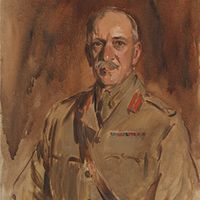
The first Terrace Old Boy to see active service was Thomas Dodds, who served as a Captain with the 5th Queensland Imperial Bushmen during the Boer War. Since then, over 800 Terracians have served in a theatre of war. Of the 800 who served, just over 100 died in service of their country.
During the Boer War, Dodds was Mentioned in Dispatches, awarded the Distinguished Service Order, and promoted to honorary captain. Dodds remained in Australia at the outbreak of the First World War and was responsible for recruitment to the Australian Imperial Forces. In 1917 he was appointed to the staff of Lieutenant-General Sir William Birdwood as a deputy adjutant general. In 1918 he became the Commander of the AIF Administrative Headquarters in London.
First World War – 1914-18: Terence McSharry (GT 1895)
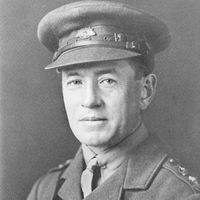
Terence is Terrace’s most decorated soldier. He was awarded the Military Cross for Exceptional Bravery during fighting in Gallipoli. In his diary, McSharry noted:
The sight from our trenches looking towards the Turks is a grim one. Turks and Australians lying together in heaps…Sleep is a luxury we know nothing about. The men are heroes, digging all day and fighting all night. We are losing men all the time..
McSharry went on to fight on the Western Front in France. He was mentioned in dispatches and awarded the Distinguished Service Order for Devotion to Duty and the Companion to St Michael and St George. During a battle on the Somme in 1918, McSharry stopped to help a wounded soldier and was mortally wounded. He is buried in France.
Second World War – 1939-45: Gerard Windsor (GT 1938)
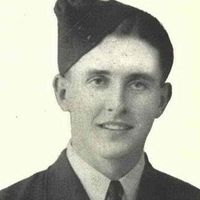
Windsor was a member of the RAAF and Bomber Command during the Second World War. Over 10 000 Australians served with the Royal Airforce’s Bomber Command during the Second World War, 3486 were killed in action, and 650 died in training accidents.
Windsor flew 82 sorties during his three months at Bomber Command in 248 Squadron. He flew reconnaissance flights, attacks, patrols, naval escorts, fighter interceptions and air-sea rescues over Norway, Holland and Denmark. According to records, he was the first Old Boy to shoot down an enemy aircraft. Windsor was at the end of his tour of duty when he disappeared on 25 May 1942 over the North Sea. The plane and its crew were never found. The Windsor family were not given proper confirmation of his death until after the war in 1946.
British Commonwealth Occupation Force 1945-52: William Keane (GT 1937)
The BCOF was formed in 1945 and was the first time Australians were involved in the military occupation of a sovereign nation. At the peak of its involvement, the Australian component of the BCOF was responsible for over 20 million Japanese citizens and over 57 square kilometres of country.
Keane arrived in Japan after serving in the Pacific shortly after the end of the Second World War. He spent four years with the Occupation Force in Japan. On his first tour, he was in command of the Karuga Naval Barracks located only eight kilometres from Hiroshima. During his second tour, Keane was Commandant of the Headquarters at Empire House in Tokyo. Keane wrote of his experiences.
I went to Kure initially, which had been a big naval base but was now in ruins. The harbour was full of sunken warships, aircraft carriers, battleships, cruisers; you could see them all on the bottom with the tops exposed…Tokyo had been absolutely destroyed, while Hiroshima resembled a saucer, with the bomb having destroyed everything from edge to edge.
Korean War 1950-53: Arthur Pembroke (GT 1945)

Arthur (Bushy) Pembroke arrived in Korea in 1951 after graduating from Duntroon in December 1950. Pembroke received the sword of Honour at Duntroon for excellence of conduct and performance of duty. Within a month of being in Korea with the 3rd Battalion, Pembroke was awarded the Military Cross for gallantry at the battle of Maryang San. On 6 October, Pembroke’s platoon was responsible for capturing the high point codenamed Sierra. His platoon then held it for 48 hours against multiple and vicious counterattacks. For his leadership of the platoon and personal bravery during the battle, he was awarded the Military Cross. Pembroke recalled his experience:
At 8.45pm the Chinese attacked – then all hell broke loose, small arms, bugles, yelling, although the main attack was directed against B Company, but we got our share. Basically we just fired, threw grenades and relied on artillery until the fighting stopped after midnight.
Malayan Emergency 1948-1960: Hugh Conaghan (GT 1935)
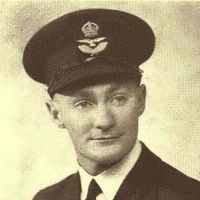
Hugh Conaghan joined the RAAF at the outbreak of the Second World War and had a distinguished record as a Beaufort pilot in the New Guinea campaign, earning a Distinguished Flying Cross. At the conclusion of the war, he was posted to Malaya, and in 1951 was awarded a Bar to the DFC for outstanding skill and leadership against the Communist bandits. In 1952 Conaghan was sent to England on an advanced course for jet training with the Royal Airforce and was accidentally killed while on a training flight in 1954.
Vietnam War 1962-75: Hugh Lunn (GT 1959)
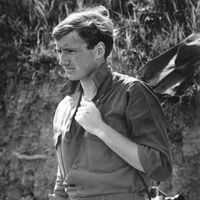
Hugh Lunn served his country from a different perspective. He was sent to Vietnam in 1967, at the age of 25, as a war correspondent for Reuters. Hugh arrived in Vietnam at the height of the war and witnessed some of the most tragic events to unfold, including the Tet Offensive.
When working in Vietnam, Hugh wore an American uniform to ensure he was not accidentally shot by the Americans while out in the field. When Hugh returned to Australia after the Tet Offensive, he was disappointed to realise the Australians were ignorant of the events unfolding so close to home. He wrote his award-winning book Vietnam, a Reporters War after returning to Australia – it took 17 years to be published.
Peacekeeping – East Timor 1999-2000: Michael Slater (GT 1976) AO, DSC, CSC
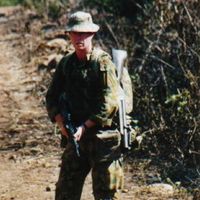
Major General Mick Slater commanded the 3rd Brigade Royal Australian Regiment in East Timor as a part of the Australian led INTERFET force. Mick was awarded the Distinguished Service Cross for his distinguished command and leadership while commander of 2 RAR on Operation Warden in East Timor. The mission restored peace and stability to a country that had suffered a breakdown of civil authority and order.
In January 2011, Mick was appointed to lead the Flood Recovery Taskforce overseeing recovery from the 2011 floods. He was appointed as an Officer of the Order of Australia in the 2012 Australia Day Honours list.
Post 9/11 Afghanistan and Iraq 2001-2014: Paul Bowes (GT 1995)
Squadron Leader Paul Bowes was awarded the Conspicuous Service Cross (CSC) in the 2021 Queens Birthday Honours List for outstanding achievement in air-to-surface combat support integration training at Number 4 Squadron for the Royal Australian Air Force. Number 4 Squadron is the Combat Control Team and has the important job of being the first on the ground to assess the viability for aircraft and personnel arrival.
Paul has served in the RAAF since he graduated from university with a Bachelor of Engineering in 1999. He is currently working in the RAAF as a Test Pilot and Operational Test Director, P-8A Poseidon.

















